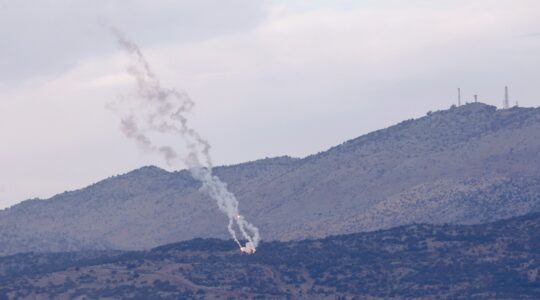NEW YORK (JTA) – The following is a time line of key events in Israel-Syria relations from 1947 to the present:
November 1947 — Syria opposes the U.N. General Assembly’s partition plan envisioning Jewish and Palestinian states existing side by side.
May 1948 — Syrian and other Arab armies invade when the State of Israel is proclaimed.
July 1949 — Israel and Syria sign armistice agreement, but sporadic hostilities continue.
1951-1956 — Syria and other Arab states provide financial aid and refuge to Palestinian terrorist groups, or fedayeen, which launch repeated raids on Israeli targets.
June 1967 — Israel captures the Golan Heights from Syria during the Six-Day War.
October 1970 — Hafez Assad launches a coup and seizes control of Syria.
October 1973 — Syria is stymied trying to recapture the Golan in Yom Kippur War.
May 1974 — After months of Syria-Israel clashes following the Yom Kippur War, the two sides agree to a cease-fire mediated by U.S. Secretary of State Henry Kissinger. A U.N. observer force takes up position in a buffer zone on the Golan.
December 1981 — Israel unilaterally annexes the Golan, though the move is not internationally recognized.
October 1991 — Israel and Syria attend the U.S.-brokered Madrid conference aimed at achieving a comprehensive Middle East peace, but fail to reach an accord.
July 1992 — Israeli Prime Minister Yitzhak Rabin vows to accelerate peace moves with Israel’s Arab neighbors.
1993-1994 — Israel-Syria negotiations become stuck on the scope of Golan territory to be returned to Syria. U.S. Secretary of State Warren Christopher shuttles between Jerusalem and Damascus in an attempt to advance talks.
June 1995 — Israeli and Syrian military negotiators meet in Washington.
December 1995-February 1996 — Israeli and Syrian delegations hold a series of talks at the Wye Plantation in Maryland.
March 1996 — Israeli Prime Minister Shimon Peres suspends Israel-Syria negotiations when Assad fails to condemn a series of Hamas terrorist attacks in Jerusalem and Tel Aviv.
May-June 1999 — Ehud Barak, a former negotiator in Israel-Syria talks, is elected Israeli prime minister, and President Assad praises him as a “strong and honest” leader who wants peace with Syria.
July 1999 — Former Israeli Prime Minister Benjamin Netanyahu discloses that he had indirect contacts with Assad during his three years in office. He says no agreement was reached because Israel refused to accede to Syria’s demand for a full Israeli withdrawal from the Golan.
Dec. 8, 1999 — After U.S. Secretary of State Madeleine Albright holds separate meetings with Assad and Barak, U.S. President Bill Clinton announces that Israel and Syria have agreed to resume peace talks.
December 1999 — Barak and Syrian Foreign Minister Farouk al-Sharaa meet for the highest-level talks ever between the two countries.
January 2000 — U.S.-brokered Israel-Syria peace talks in West Virginia collapse over the scope of Golan’s return and water access rights to the Kinneret.
June 10, 2000 — Assad dies and is succeeded by his son, Bashar.
February 2007 – Olmert meets with Turkish Prime Minister Recep Tayyip Erdogan in Turkey and lays the groundwork for a Turkish role in mediating with Syria.
Sept. 6, 2007 — Israeli warplanes bomb a suspected nuclear site in Syria.
May 21, 2008 — Israel and Syria announce they are holding indirect peace talks via Turkish mediation.





